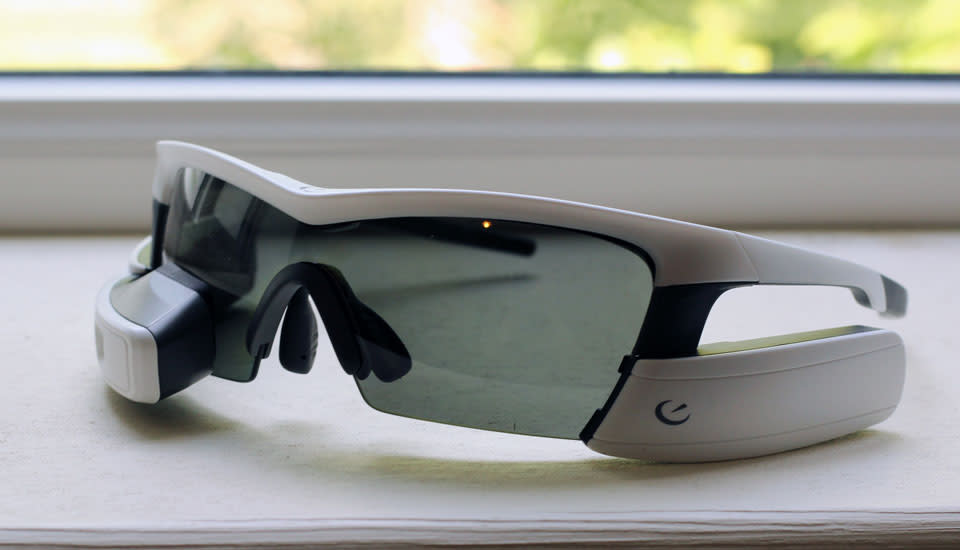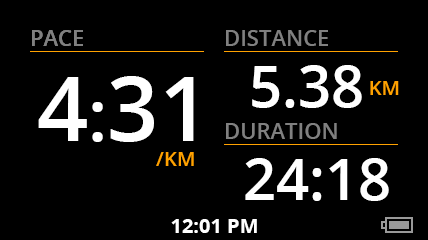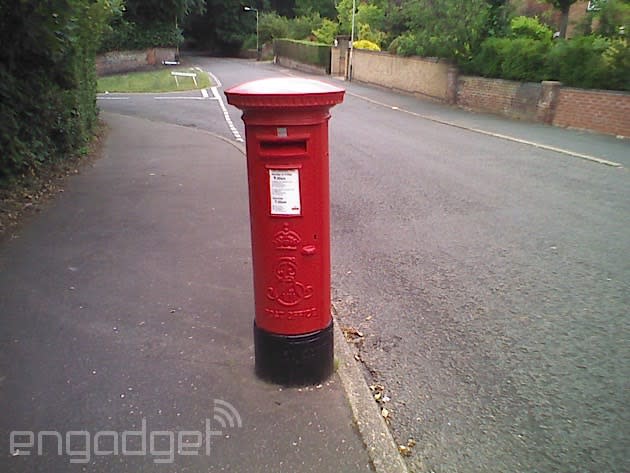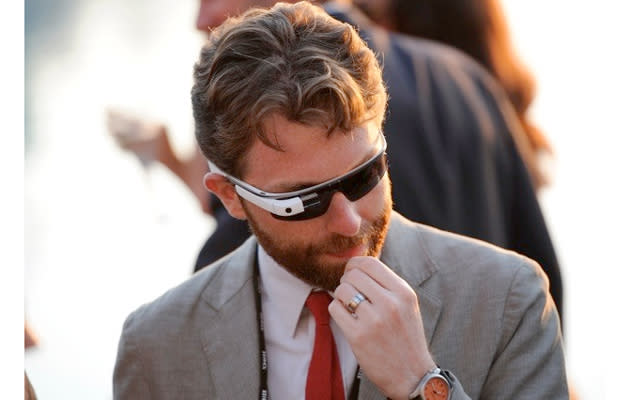Recon Jet review: expensive fitness glasses with potential to be better

Recon Jet is a sports computer for long-distance runners and cyclists that's embedded into a pair of sunglasses. Take it on a long, lung-bursting trip and you'll get your speed, cadence and calories, as well as a variety of other stats -- all presented to you on a tiny display placed just below your right eye. At $699, it's priced for the hardcore athletes (and it's certainly catering to that corner of the market). Normally we might not bother with such a niche device but as it happens, the company was recently acquired by Intel for $175 million. As such, we thought it was worth a closer look to see if it heralds a fresh start for face-worn computing -- or if will suffer the same fate as Google Glass.
Hardware

Shove the Jet onto your face and you'll find the compute module on the right-hand side, which contains the meat and potatoes of the device. That includes the display, camera, GPS module, charging port and controls, while a swappable battery pack is tucked in on the left. Yes, the micro-USB port for power is not on the battery, because power is transmitted back and forth via a microfilament that's embedded into the lenses themselves. This means that you won't be able to run to your local opticians for a replacement, or get prescription or tinted lenses. The company has said it's working on offering these options, but most of these additional pieces rely on the device becoming fatuously successful before the R&D money begins to flow.
Effectively it's a low-end Android smartphone that's been squeezed in to sit beside your face. Tucked beneath the plastic you'll find a 1GHz dual-core Cortex-A9 CPU, 1GB of RAM and 8GB of storage along with the various GPS, WiFi and gyro sensors. In addition, there's a 2.1-megapixel webcam poking out the front, as well as a WQVGA (400 x 240) display and an infrared glance-detection sensor that'll enable the unit to save power by frustrating you to death -- see below for more details.
Fashion isn't just about what you wear, but how you wear it, and it's here that Recon paints its users into a corner. If you're traditionally seen in Oakley sunglasses and a North Face windbreaker, then you'll have no trouble wearing this device. I, on the other hand, look like some out-of-touch government minister on an awkward press trip to a factory. That's not to rag on the Jet's styling, but to say that the only way for this to not be incongruous is to wear cycling spandex and a crash helmet.
In use

In the intro, I said that Recon Jet was designed for long-distance runners and cyclists because the sort of granular data that it provides isn't that useful for casual exercisers. The first time I took the device out on a run with me, I left my smartphone at home to see how well it operated without help. This was a mistake, because I was nearly a third of the way through my journey before the hardware locked onto a GPS signal.
Switching on the unit can also be problematic since there's no simple way to tell that it's loading if you aren't standing in front of a mirror. The first time I took it out, I pushed the "on" switch and waited for something to happen, only to be met with a black screen. So, I took it off to check that the white LED that signifies power, situated at the back of the compute module, was actually on. Unfortunately, the system has an infrared sensor that knows when the device isn't being worn, and powers down accordingly to preserve battery life. You can probably work out the rest for yourself.

Once it's working, it's just like being in a video game since you're getting all of this instant data pumped straight to your right eye. The default is for you to be able to see your distance (km or miles), duration, speed (KPH or MPH) and calories, with the option to tweak that further. If you pair the gear with a heart rate monitor or cadence sensor you can also get those two stats, as well as your average power and elevation. You're only allowed four windows per screen, but you can add up to six pages that you can swipe through when you're on the go. It's possible to get all of this data from a connected smartphone, sure, but there's something slightly unreal -- in a good way -- about it sitting in your peripheral vision.
As a nearsighted glasses wearer, I don't want to talk too much about my experience with the display because I just forwent glasses or lenses during my testing; your mileage will obviously vary. I will say, however, that I wish the company had mounted the arm a little higher up. I had the screen tilted at an extreme angle to make it easy for my eyes to peep the data and still, looking down like that on a regular basis wasn't that comfortable.
In order to sync your progress with Recon Engage, the company's cloud-based fitness service, you'll need to download Recon Uplink to your Windows PC or Mac. In addition, there are Android and iOS mobile smartphone apps.
If there's one phrase I'd use to explain my experience of syncing the device to my desktop, it'd be, "There was an error; please reconnect or restart your HUD." Recon Uplink would frequently stall when I tried to upload my jaunts and wiped a chunk of my exercise history when I accidentally opted for an OS update. In addition, it would often disconnect itself and then lecture me about it, when I'd done nothing to anger it. These issues became less frequent with each update, but it's still something that could -- and should -- have been remedied before the hardware left the warehouse.
Recon Jet runs ReconOS, the company's homegrown fork of Android that's been skinned beyond recognition. When you activate the device, the first thing you'll be dropped into is the top menu, where you'll be offered to start a New Activity, while swiping left and right presents panes for apps, records, notifications and settings. Drop down into the apps menu and you'll be presented with a similar left-right screen offering you a camera, compass, gallery, map and music player. Interestingly, these icons seem cribbed from Microsoft's Metro design rather than Android. I'm not sure if I appreciate the shift in tone between menus, but it does make it easier to tell you where you are if you've got one hand on a handlebar.
Navigation

Plug the Recon Jet into your desktop and visit the companion website and you'll be able to download maps that you can use offline. You can select multiple locations; the only limit being that the total area of your selections is no larger than 10,000 square kilometers. Then, the next time that you're out and about, you can use the wearable as a rudimentary navigation tool. Yes, it sounds cool, but there are some limits to what you can do with the technology.
When it's on your head, it'll take around 40 seconds for maps to load, and then you'll be presented with a Grand Theft Auto-style overhead map view. In fact, given its placement in the lower corner of your vision, you do feel very much like you're inside one of those games. Unfortunately, there are no road markings and no way to produce even a rudimentary guided navigation tool that'd let you plot an unfamiliar route before you left home. It's not a huge problem, per se, but it's certainly something that we'd like to see fixed in a later update.
Camera

When I sat down with Recon Chief Marketing Officer Tom Fowler this past January, he said that the Jet's camera was, essentially, for those moments when you're out on your bike and you spot something cool. In his example, he was cycling through a forest outside Vancouver and saw a deer that had bolted by the time he had gotten his phone out. The 2.1-megapixel camera on the glasses would never replace your smartphone or DSLR, but it's useful for quick moments when you need something to shoot with.
The fact that this isn't really designed for regular usage and the fact that it has a resolution of just 2.1 megapixels means that it's hard to get snippy about the images it produces. They're just as bad as the ones on a budget smartphone from a few years back, all blurry edges and washed-out color. You're certainly not going to be looking at anything in detail on this, nor will you be able to zoom into anything for up-close looks. On the upside, the photos that you take on your trips will be uploaded to Recon Engage, although there's no option to share them straight from your dashboard.
In that same vein, the Jet won't behave as a substitute for a head-mounted action camera like a GoPro or Drift. The device can shoot video clips with sound, but only for instances of 15 seconds at a time. On the upside, the clips are smooth and there's very little interlacing or judder, but on the downside, they're still washed out, have difficulty handling over or under-lit areas and lack detail. I'd say that you'll probably not want to use this mode either; in fact, let's just steer clear of the camera unless you really have to, okay?
Other features

ReconOS is based on Android, so the hope is that developers will treat the Jet as a "platform" rather than a device and craft apps for it. For now, however, there are only two other features that we haven't touched upon: "Compass," which visualizes what direction you're pointing in, and music playback. This is a bit of a misnomer, since you're just using the HUD to control the tunes that are blasting out of your smartphone over Bluetooth. You can play/pause, alter the volume and swipe between tracks with the touch panel, and, er, that's it. Much like the other options, it takes so long to access the feature that it's highly unlikely that you'll ever use it. Even worse, is that if you're using another feature, like Maps, you can't just jump out, change the track and leap back in. Instead, you have to wait for the device to reload the feature, which becomes a real annoyance after a while.
The competition

There are head-worn fitness devices and there are head-worn computers, but only the Recon Jet straddles the line between the two. If you wanted a gadget that simply tracked your activity and happened to sit atop your skull, then we'd point you in the direction of a LifeBeam Helmet or Spree Headband. If you wanted something that can do more than just track your movement, then Google Glass is probably your only option. Oh, and we're not including head-mounted VR/AR devices in this list either, since that's an entirely discrete country in the land of gadgets.
Except, of course, Google has pulled its first-generation wearable from the shelves in the hope that Tony Fadell can do something useful with it. In the meantime, you can hunt around on eBay for a set, some of which are being sold for less than $500 if you're prepared to be patient. Otherwise, you'll be limited to various sets of enterprise-level "smart glasses" like Epson's Moverio Pro BT-2000, which is likely to be priced well out of the hands of the likes of us.
Wrap-up

Between the start of this review process and its publication, Recon Instruments was purchased by Intel in a deal reportedly worth $175 million. I've judged this device by the standards of a scrappy hardware startup, but it's important not to ignore that, now that the Jet has been released, it's being backed by a company with a market cap of $140 billion. Much like Basis, another wearable outfit that Intel acquired, Recon now has enormous financial and technical muscle that it can put at its disposal, and it needs it.
There are plenty of things that are wrong with the Recon Jet, but the idea behind the technology isn't one of them. Thanks to Google Glass, head-worn computing had become a punchline to a tired old joke, but this device has breathed new life into the concept. Crafting a product that does a specific job within a specific niche is an excellent point to begin working from. Those good fundamentals, however, have yet to be realized as a product that I can recommend that you buy.
The whole thing could do with being shrunken down so it's less prominent on your face, and introducing symmetry wouldn't be a bad thing, either. The operating system works fine, but the user interface is probably two buttons and a serious rethink shy of being as elegant as it should be. Don't forget, the target consumer is a cyclist sprinting down roads -- not someone who can easily pause their journey to futz with submenus. In addition, everything's just so painfully slow, there's little benefit to using this over a high-end cycling computer that could be as easily glanced from a handlebar mount.
But.
One thing that Recon is very good at is iterating, and the company pushed out two software updates in two weeks to improve the system. Overall performance has become snappier and, if you keep your phone with you on a ride, you can off-load GPS pairing to that device, cutting the loading time by a substantial margin. If the company can continue to refine, slim down and fix the most friction-inducing issues in the Jet, then it's likely that it'll be purchased by high-end cyclists. Until then, you probably would be better off sticking to a far cheaper cycling computer and waiting for the second generation.






























